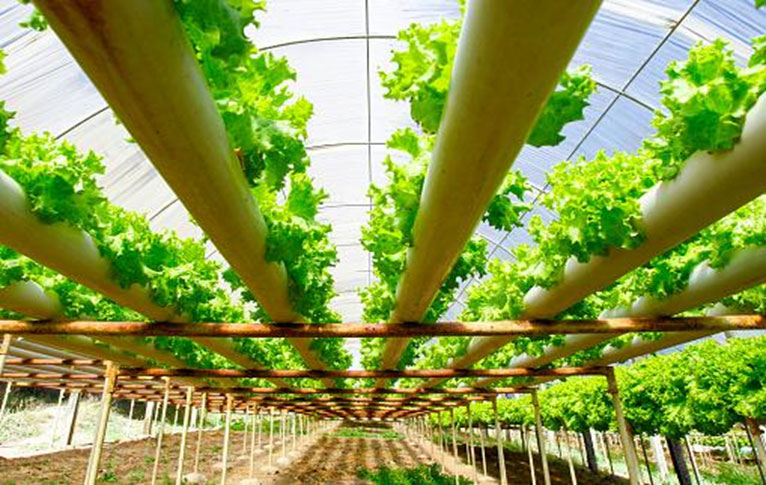As the global population grows and arable land becomes scarcer, traditional farming methods face significant challenges in meeting food demand. Hydroponics farming has emerged as a sustainable alternative, allowing farmers to grow more crops with less water and space. This innovative method harnesses water-efficient techniques and space optimization to produce higher yields, making it a game-changer in modern agriculture.
1. What is Hydroponics Farming?
Hydroponics farming is a soilless method of growing plants using a nutrient-rich water solution. Instead of relying on soil to deliver nutrients, plants are suspended in various mediums, such as water, coconut coir, or perlite, allowing their roots to directly absorb nutrients and oxygen. This controlled environment encourages faster plant growth and higher productivity, often in smaller spaces.
Key Components of Hydroponics:
- Nutrient Solution: The water in hydroponic systems is enriched with essential minerals and nutrients required for plant growth.
- Growing Medium: Instead of soil, materials like perlite, rock wool, or clay pellets are used to support plant roots.
- Watering Systems: Various methods, such as drip systems, aeroponics, or deep water culture, deliver nutrient-rich water to the plants.
2. How Hydroponics Conserves Water
One of the greatest benefits of hydroponics is its ability to grow crops with significantly less water than traditional soil farming. In fact, hydroponics uses up to 90% less water than conventional agriculture.
Water Efficiency in Hydroponics:
- Recirculation: Hydroponic systems often recirculate water, ensuring that any unused water is collected and reused instead of being lost to evaporation or soil runoff.
- Direct Nutrient Delivery: Since plants receive water directly to their roots, there’s less waste compared to soil-based methods where much of the water is lost to seepage.
- Precise Control: Farmers can precisely control the amount of water plants receive, reducing overwatering and ensuring water is used efficiently.
3. Maximizing Space with Hydroponics
Hydroponics farming excels at maximizing space, making it an ideal solution for urban areas, greenhouses, and locations where land is limited. In many cases, farms can produce more crops per square foot than traditional methods.
Space-Saving Techniques:
- Vertical Farming: Hydroponic systems can be stacked vertically, allowing multiple layers of crops to be grown in the same footprint. This is particularly useful in urban settings where land is limited and expensive.
- Compact Systems: Hydroponic farms are highly scalable, meaning they can be set up in smaller spaces like rooftops, basements, or even indoors.
- Year-Round Growing: By controlling light, temperature, and nutrients, hydroponic farms can operate year-round, eliminating the need for large expanses of seasonal farmland.
4. Higher Yields in Less Space
Hydroponics offers the potential for higher yields per square foot than conventional farming. Because plants receive a constant supply of nutrients and water, they grow faster and more efficiently. In addition, hydroponics systems can be designed to grow crops closer together without competition for nutrients.
Benefits of Higher Yields:
- Shorter Growing Cycles: Crops mature faster in hydroponic systems, allowing for more growing cycles per year.
- Optimized Growth Conditions: Farmers can fine-tune every aspect of the growing environment, ensuring plants receive optimal conditions for maximum productivity.
- Less Crop Loss: In a controlled environment, crops are less vulnerable to diseases, pests, and extreme weather, leading to lower losses and higher overall yields.
5. Sustainability and Environmental Impact
As concerns about climate change and resource depletion grow, hydroponics farming offers a more sustainable alternative to traditional agriculture. Not only does it use less water and space, but it also reduces the environmental impact in several ways.
Sustainable Features of Hydroponics:
- No Need for Arable Land: Hydroponics farms can be established in areas unsuitable for traditional farming, such as deserts or urban environments.
- Reduced Pesticide Use: With no soil to harbor pests and diseases, hydroponics reduces the need for harmful pesticides and chemicals, making it an eco-friendly option.
- Lower Carbon Footprint: Many hydroponic farms, especially those located near urban centers, reduce the carbon footprint associated with transporting food over long distances.
6. Best Crops for Hydroponic Farming
Certain crops thrive in hydroponic environments due to their fast growth and high water efficiency. Farmers can choose from a wide variety of vegetables, herbs, and even fruits to grow more with less water and space.
Popular Crops for Hydroponics:
- Leafy Greens: Lettuce, spinach, and kale are perfect for hydroponic systems due to their quick growth cycles and space efficiency.
- Herbs: Basil, cilantro, and mint are in high demand and grow well in hydroponics with minimal space.
- Tomatoes: Although requiring more maintenance, tomatoes yield impressive results in hydroponic systems and can be highly profitable.
- Cucumbers and Peppers: These crops also perform well, providing high yields in smaller spaces compared to traditional farming methods.
7. The Future of Farming with Hydroponics
Hydroponics represents a shift towards more sustainable and efficient farming methods. As technology improves and more farmers adopt this method, hydroponic farming is likely to play a vital role in feeding the growing global population while conserving water and land resources.
Key Trends Shaping the Future of Hydroponics:
- Urban Farming: With the rise of urbanization, hydroponic farms are making it possible to grow food closer to consumers, reducing transportation costs and environmental impact.
- Tech Integration: Advanced monitoring systems, automation, and AI are enabling farmers to optimize water usage, nutrients, and crop health, making hydroponics even more efficient.
- Global Food Security: In regions suffering from drought or limited agricultural space, hydroponics offers a viable solution to growing food locally and sustainably.
Conclusion
Hydroponics farming is revolutionizing the way we grow food, offering a solution to the challenges posed by limited water and space. By adopting hydroponics, farmers can grow more crops with less water, maximize their yields in smaller areas, and contribute to a more sustainable future for agriculture. As we continue to face global food and resource challenges, hydroponics stands out as a promising method for feeding the world.



